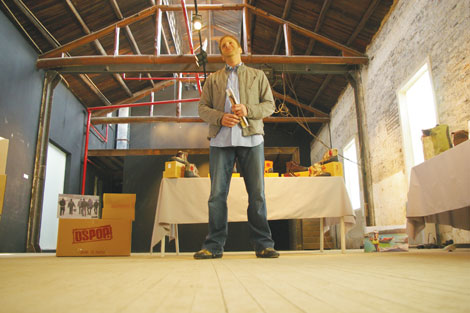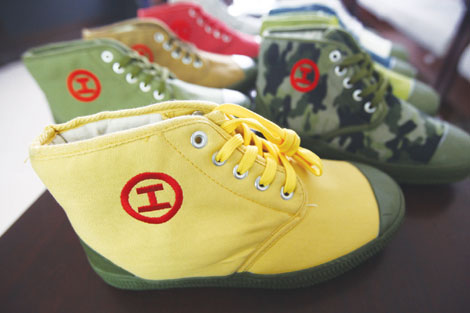Specials
Old style returns to resounding success
Updated: 2011-01-14 10:55
By Zhang Kun (China Daily European Weekly)
 |
|
Ben Walters introduces how he re-invented Jiefangxie shoes at the launch of his Ospop products in Shanghai. DAVID PANDT / FOR CHINA DAILY |
Like the phoenix rising from the ashes, many old fashion products are finding favor again in the fashion capitals of Europe and Shanghai.
Jiefangxie, the green canvas shoes with soft rubber soles and toecaps and worn by almost everyone in China during the 1950s and 1960s, is making waves on the fashion circuit.
Middle-class consumers have shown increasing interest as aggressive marketing blitzes in Paris and Milan have helped the iconic products rather than the nostalgia factor.
Jiefangxie, or liberation shoes, reemerged on the fashion scene in late 2007 after American businessman Ben Walters decided to cooperate with a local manufacturer to make updated versions of the shoes. Walters expected the products to find favor in the fashion capitals of Europe and the United States as demand for goods made from China was heating up.
Response from the international markets for the Jiefangxie has been good with sales of more than 20,000 pairs in the last three years. The shoes, which used to be widely available in China for about 10 yuan (1.2 euros), are sold for about 53 euros, after being redesigned and improved, under the brand name Ospop (One Small Point of Pride).
In late December last year, the 35-year-old American started selling his products in Shanghai. He also announced the opening of an online shop at the press conference for the Ospop launch held in a studio under renovation on Jianguo Road in downtown Shanghai, where one can find migrant workers wearing Ospop atop scaffoldings putting finishing touches on the walls.
The original Jiefangxie was an olive green canvas shoe used by the People's Liberation Army during the 1950s. Other colors that were produced were for civilian use. The shoes were comfortable and durable and considered affordable at a time when monthly wages of the Chinese workers were about 36 yuan.
Based on the same design and materials but of superior quality, Walters' Jiefangxie are targeted as fashion products for the niche market. It has outlets in Italy, New Zealand and the US, but most of its sales comes through its website Ospop.com.
"The global fashion industry is hungry for creativity from China," says Ian Lin, a Shanghai-based fashion critic. "This has brought great opportunities for China's creative sector. Western customers are likely to be attracted by the story behind Jiefangxie, just like the retro Huili sneakers making a huge comeback in the international fashion scene after Hollywood star Orlando Bloom wore them during a fashion shoot.
"I've gotten compliments from both guys and gals. They are amazingly comfortable too - some of the nicest-feeling shoes I have worn ever," says an article in popular gear review blog Practical Travel Gear on the latest Steppe series of Ospop shoes.
"The soles are supportive and flexible and good for work," says a worker surnamed Shi. The Departure series of Ospop, worn by Shi, retails at $48 (37 euros) on the Ospop website, and at a promotional price of 118 yuan on its newly launched online store for Chinese customers.
"I don't know if the Chinese market is ready for the industrial fashion style yet," Walters says. But they are very popular in the developed world, such as North America and Europe. "Brands like Levis and Cat have successfully adopted industrial work wear into fashion statements. I want to follow in the same path," Walters says.
But the road has not been all that easy. Walters came to Shanghai in 2003 for his family business of plastic materials and accidentally picked up a pair of Jiefangxie from a street-side stall. Soon he realized these shoes were everywhere. Enthused by the simple and clean-line style, he decided to establish his own shoe brand.
"China has 120 million migrant workers. This is larger than the population of all but 10 countries in the world. Without them all the rapid changes and amazing developments would not have been possible. These people are an integral part of the culture, and they contribute a lot to the community, but they are hardly celebrated in China," Walters says. "They are surely worthy of celebration."
 |
|
The updated Jiefangxie is priced at about 53 euros. TANG YULEI / FOR CHINA DAILY |
Walters hired a shoe designer to optimize and update the Jiefangxie. He decided to use a high performing insole; better functional details and an original design embedded with Chinese calligraphy patterns for packing the product.
With the design in place, the next step was to find an ideal mass manufacturing location. For this he traveled from the north in Harbin to Dongguan in southern China before zeroing in on three manufacturing bases.
Last month Trend Report, an independent consumer trend watcher, put Ospop in a list of 50 must-see consumer innovations from China and other emerging markets.
"The market is fragmented and too difficult to analyze. But it is more ready than three years ago when we just launched the brand," Walters says.
At the same time, he also realized that China's younger generation - the post-1980s - were more familiar with Western fashion and would be his best target market. With an eye on this market, Walters intentionally lowered the price of his products.
That gesture seems to have paid off, going by the early response. Such was the demand that as soon as Ospop hit the Western markets, many businessmen started selling pirated versions of the shoes in China.
On China's largest online shopping platform, Taobao.com, a quick search for "Ospop" will reveal more than 100 sellers of the shoes, with some even displaying photographs copied from the official Ospop website.
Despite the widespread piracy and intellectual property (IP) infringement, Ospop still decided to start its sales in China on Taobao.com, preferring its convenient payment channel and accessibility to consumers.
Walters decided to focus on creating and innovating, believing that is the best way against IP infringement on and off the Internet. He plans to open more shops in China and expand the product line from shoes and bags to apparel and accessories.
"Ospop will have to keep innovating and creating in order to attract the fashion-savvy youth of China, because the simple style alone may not be sufficient. It will also help the company earn better prices and attract more sophisticated clientele," fashion critic Lin says.
Specials

President Hu visits the US
President Hu Jintao is on a state visit to the US from Jan 18 to 21.

Ancient life
The discovery of the fossile of a female pterosaur nicknamed as Mrs T and her un-laid egg are shedding new light on ancient mysteries.

Economic Figures
China's GDP growth jumped 10.3 percent year-on-year in 2010, boosted by a faster-than-expected 9.8 percent expansion in the fourth quarter.